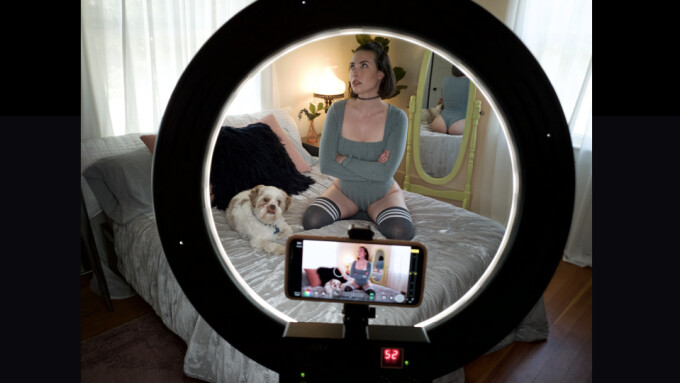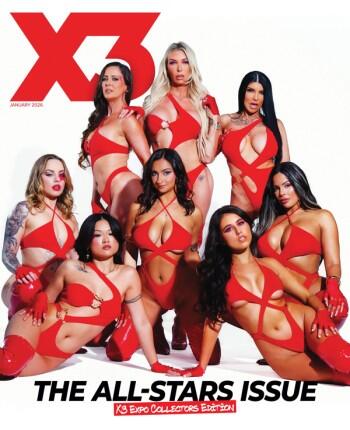LOS ANGELES — With adult performers unable to report to professional sets during the COVID-19 pandemic, and with no clear end to the current public health crisis, studios and platforms have announced several initiatives to purchase and distribute made-at-home content directly from performers.
But made-at-home does not mean that content necessarily need to look and feel “homemade,” or even “amateur” (or pro-am in this case, since the models in question are professional performers).
By April 2020 — Month Two of the worldwide quarantine — isolation protocols have witnessed the steady rise of Performer-Producer (PerPro) content: material produced at home by performers specifically to be sold to studios that is meant to be monetized alongside professional studio offerings.
PerPro content shares elements with home-crafted, DIY content that existed in the “Before the Virus” era — like clips for clip sites and premiums, customs, content trades, BTS, candids, pro-am, even some elements of camming — but it has the crucial distinction that content-starved big players in the industry are now willing to pay performers top-dollar for it.
Some of the largest and most high-profile adult companies — brand names like Brazzers, Next Door Studios, Twistys, Adult Time and Vixen Media Group — have rolled out content initiatives that include investments in equipment and tutorials to be sent to their brand-new PerPro partners.
The competitive advantage in this new scenario, of course, belongs to performers who have previous experience with audiovisual content. Those performers who know their way around cameras and microphones — editing can still be done by the studios remotely — will be at the cutting-edge of PerPro content, and those who don’t should probably consider a crash course.
XBIZ asked several experienced performers and producers about tips they may have for models now facing the new challenge of making home-made content that will differentiate itself from all the other PerPro offerings being shot, and also not look out-of-place as a big studio update.
We spoke to Casey Calvert, a performer and director who has extensive experience creating custom clips; Matiland Ward, the Deeper.com contract star who transitioned from mainstream acting to porn via cosplaying and self-made content; Ginger Banks, an award-winning cam model and clip artist who has been creating DIY content for a decade; Joanna Angel, an in-demand performer-producer who is also a pioneering figure in alt-porn and paysites and the founder of legacy brand Burning Angel; and celebrated adult directors Mike Quasar and Holly Randall, currently prevented from returning to their prolific shooting schedules by the production hold.
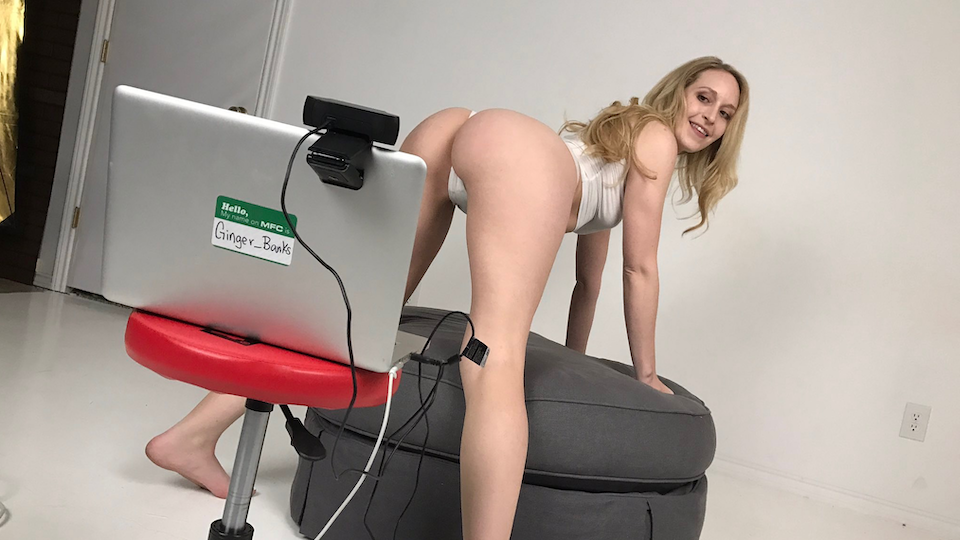
Ginger Banks (Photo: Banks)
Camera vs. Phone
Although all the professionals contacted by XBIZ marveled at the quality of iPhone and Android cameras and endorsed them as a perfectly adequate go-to for beginner PerPro creators, those wishing to step up their visual game should consider an upgrade.
“Obviously, I started out in front of the camera,” said Casey Calvert, “but my degree is in film production, so I've always tried to pay attention to how people shoot. Over the past nine years being in front of the camera, I've watched the consumer handicams and kitted-out DSLRs give way to more serious, professional cameras — largely Canons, sometimes Sony, though Vixen shoots with an Alexa.”
Calvert said she is “a big fan” of the Canon line for shooting adult content.
“The cameras are expensive but not insane, and the quality is excellent. They have a rich, warm look, and a wide assortment of lenses,” she explained.
The director, who has just released and self-produced the high-end, Netflix-quality series “Primary” for Lust Cinema, warned newbies against splurging big on gear.
“When just starting out shooting content for other people, don't go crazy,” she advised. “You can get great results from some of the under-$1,000 consumer cameras that shoot 4K, have great low-light and autofocus capabilities, which is helpful when shooting yourself, and might even offer different frame rates for a more — or less, if that's your preference — filmic look.”
Still, Calvert thinks the humble cellphone bulking up everyone's pocket should not be ignored, especially for solo shoots.
“Honestly, if you have a new iPhone or Android,” she said, “you might be better off simply using your phone. The quality is very good, and they're designed to do a lot of the work for you. They adapt to extremely difficult lighting situations and focus issues with zero effort.”
“I’m a big fan of shooting with cell phones,” Calvert added. “It's effortless in a way that a prosumer camera will never be. I highly recommend the FilmicPro app. It's not expensive, and it gives you just the right amount of control visually.”
Ginger Banks, who has been camming since the early 2010s, started with her computer camera because, at the time, “it was better than the camera on my BlackBerry,” she said. Banks eventually invested in a 4K HD camera with auto stabilization.
“It was a great camera,” she explained, “but the extra effort that shooting in 4K HD would take was not reflected in my sales, so I stopped using it. Now you can shoot 4K HD on most phones. I’d suggest new performers just use their cell phones and maybe invest in a steadicam [attachment] that works with your phone for stabilizing.”
Banks is also a fan of her phone’s front-facing camera for self-shooting because it “is very high-quality these days, so when working alone you can see yourself on the cam to make sure you’re in frame!”
For self-made content, mainstream-adult crossover sensation Maitland Ward currently uses her iPhone 11 Pro Max. "It does a fantastic job, plus there are so many editing capabilities you can do straight on your phones now," she explained. "I don’t think individual creators need to invest in any high-end pro cameras at this time, though.”
Veteran industry director Holly Randall — currently coordinating 2257 compliance and scene delivery for Twistys' content orders from models doing their own shoots at home — recommends "a tripod for your camera phone and a ring light."
"There are great combo setups on sale that have a ring light, stand and camera holder all-in-one which makes this super-easy," Randall added.
Ultimately, as Joanna Angel explained, the gear is only as good as its ability to capture the desired chemistry — and your personal comfort using it.
“When I shot ‘Lady Gonzo,’” Angel explained, “I used the Canon XC15 for the first few scenes, but then everyone convinced me the Panasonic GH5 was the best camera to use. And maybe it is — lots of people use it. But it kept going out of focus for me!”
After watching many YouTube tutorials about proper settings, Angel returned to the camera she trusted.
“I just didn’t like using the Panasonic even though it was ‘technically’ better,” she explained. “I switched back to the Canon and now that me and Small Hands have shot some stuff at home for Brazzers and other studios, I’ve been using the XC15.”
For Angel, the goal at the moment, for herself and everyone, especially newcomers to filmmaking, is not to be on the cutting-edge of adult camera equipment.
"The goal for me is really to use something that shoots in 4K and lets me capture the sexual chemistry going on in front of me," she said.
Sound Advice
Another consensus among the professionals was about the importance of proper sound recording.
According to Calvert, “where most people skimp when starting out is with audio, which is a big mistake.”
"That's going to be the big weakness on those handicams. Invest in a handheld recorder, like a Zoom, to get better audio or you can even set your phone nearby to record sound. The results will be better," she added.
Even for cell phone content, Calvert recommends an external audio recorder. The FilmicPro app, she thinks, “still leaves something to be desired with audio capture.”
Mike Quasar, a veteran of professional sets, confirms the importance of more-than-barely-decent audio to achieve pro results.
“Your phone is never going to produce good audio,” Quasar explained, “so depending on the type of content you are shooting, that may or may not be an issue. If you own a camera, my only advice is to not rely on the built-in microphone. At best, it [should] only [be] used as a reference to sync to a better audio source. Buy an external mic from Best Buy or Amazon, preferably one with XLR if your camera supports it. Otherwise, any external mic is better than the built-in option.”
Ginger Banks, speaking from traumatic personal experience, stressed the importance of testing all equipment, audio in particular, before shooting.
"Before you start filming your video, it is always smart to do a small clip where you talk and move around," she advised, "then stop recording and double check everything is working. Nothing is worse than filming an entire clip and then realizing that the sound wasn’t recording."
For Maitland Ward audio is not only crucial, but sound design itself is a highly underappreciated and underutilized element in self-made content.
“It can add so much depth and quality to the production,” she said. “Also, ASMR is fun to play with during this stressful time too — it’s soothing and sexy. A good microphone and sound editing software can do wonders.”
Also, Ward wants to remind producers to make sure they don't “have music playing in the background you don’t have the rights to, or you won't be able to sell the scene!”
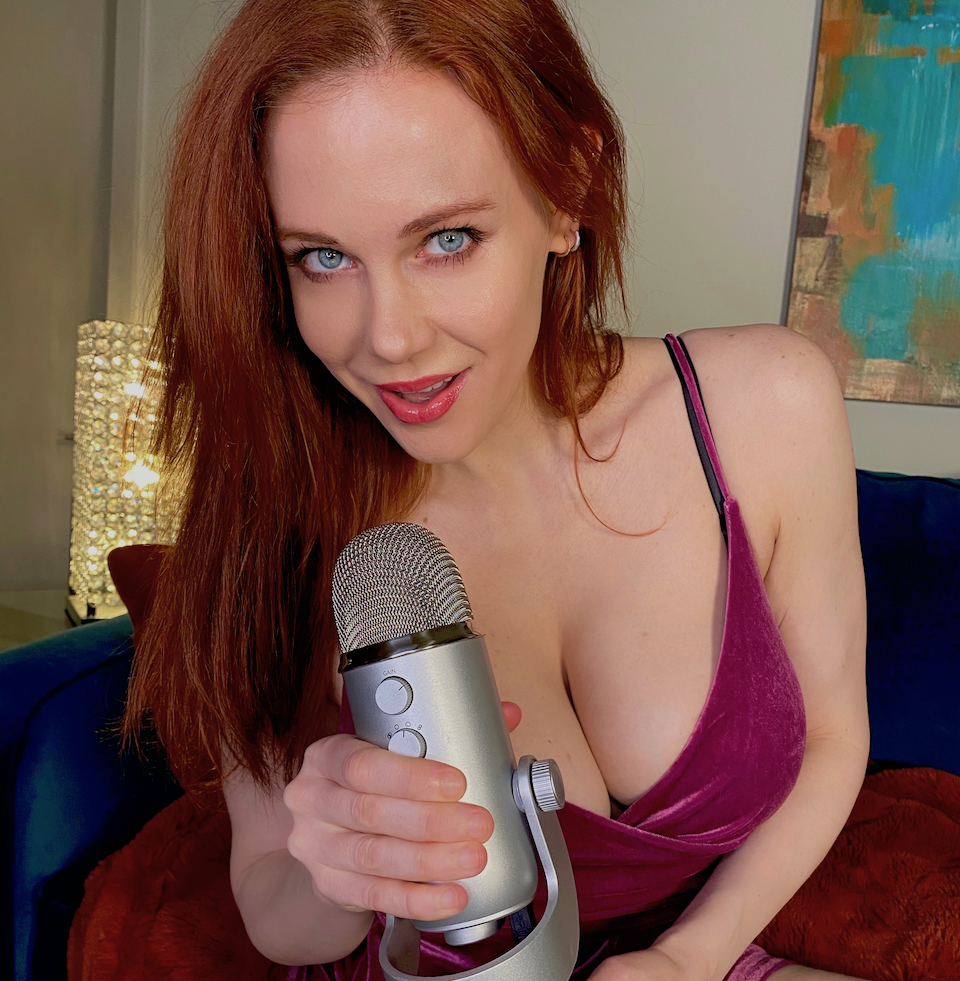
Maitland Ward (Photo: Ward)
A PerPro Prepares
As in any creative endeavor involving multiple moving parts, makers of PerPro content need to be a few steps ahead of possible issues, and should avoid over-complicating matters.
“Just try to think through all the problems you might encounter beforehand,” Calvert advised, noting a common problem of “ignoring things in the background that might pull your camera's autofocus attention off you and onto a busy pattern or bit of detail.”
“There's nothing worse than filming yourself for ten minutes only to discover the entire shot is soft because the autofocus was locked on a rattan basket in the corner,” she said. “If you have a partner or friend available, even if they aren't in production, ask them to help. Often just having another pair of eyes behind the camera can be incredibly useful.”
If a partner is not available, Holly Randall recommended placing a mirror behind the camera "to get a sense of how you look."
"Just be careful not to stare at your reflection the entire time otherwise the camera can tell you're not looking at it!" Randall added.
Calvert warned first-time directors not to make a rookie mistake of obsessing over details that can be fixed in postproduction, given that many contracting studios are only asking for the raw, unedited footage.
“Frame your shot loosely so you have some leeway to move around,” she recommended. “The editor can always crop in to tighten the shot.”
“If you don't have lights, try to shoot during the day and near windows — preferably with sheer curtains. If you decide to invest in lights, start simple. Get yourself some LED panel lights from B&H Photo or Amazon and some diffusion to soften them up. It's plenty to start. Then, watch a few tutorials online about building a basic three-light setup. There are some great ones on YouTube.”
Banks also advised beginner PerPros to start small with lights.
“There are countless different lights for you to purchase online that work for content creation,” she said. “The basic ring light works extremely well, as do lights that you can stick anywhere with magnets. Those can be found at Home Depot or a similar hardware store. The most basic setup is having the lights directly behind the camera. It also helps soften the light if you bounce it off of the walls.”
Ward thinks a large ring light “should be good for most at-home productions,” but she encouraged new producers to take advantage of natural light as much as possible.
While new producers might soon become eager to differentiate their product from other PerPro content, the temptation might arise to abuse a greenscreen (e.g. “it’s the same scene with my same quarantine partner — but we’re in Ancient Egypt!")
“Greenscreen is not your friend,” Calvert warned, based on her experience creating custom clips.
"People think that throwing a piece of green fabric in the background allows for fixing anything in post. It's a lie. Lighting a greenscreen properly is actually extremely difficult. It has to be bright and flatly lit, but in such a way that the light and color from the screen isn't spilling onto you in front of the camera.”
If sophisticated VFX like greenscreen is not something beginner PerPros already understand, Calvert stressed, “my sincere advice is don't fuck with it," lest your clip is unusable because it looks like the performers are fading in and out of the digital scenery (we've all seen those Zoom meeting grids by now).
Instead of ineptly cutting and pasting yourself into the pyramids, Ward recommended spending time to ensure your actual background, your home sets, are aesthetically pleasing.
“Color and lighting make a huge difference on how the mood is set,” she said. “I always get better responses when my set is on-point. I’m definitely not an advocate for leaving your dirty laundry and food containers lying around in the background. Some say that adds realism, but I think it looks lazy.”
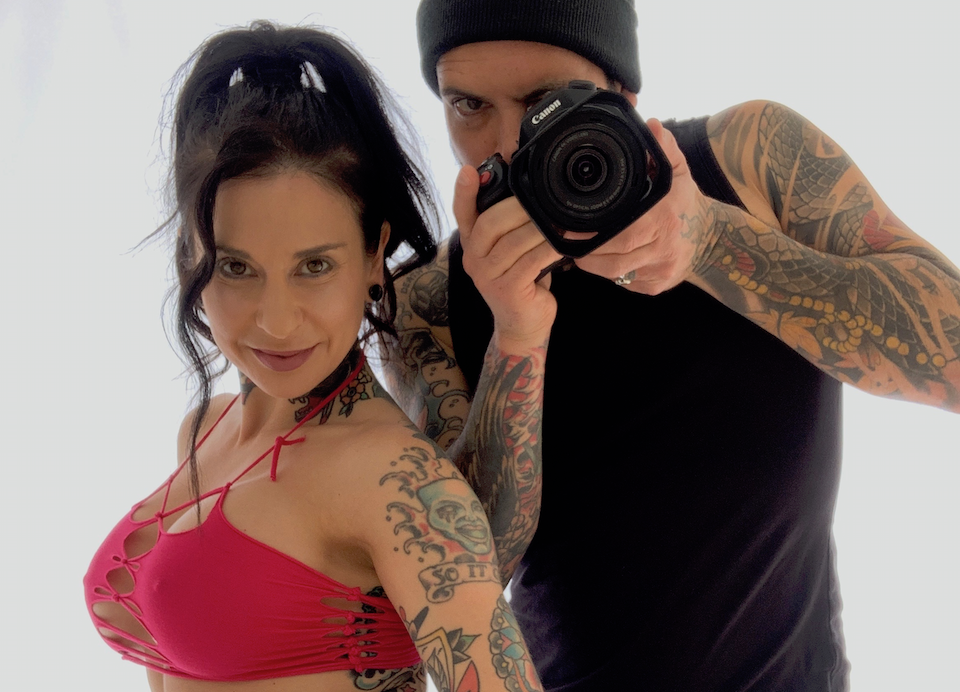
Joanna Angel and Small Hands (Photo: Brazzers' "Hands On Joanna")
Domestic (and Professional) Partners
For Ward — though having “a tripod with the light ring placed directly in front and adding the video lights on the sides” works really well most of the time — in these uncertain times, “a lot of people really appreciate the more intimate side of you just holding the camera.”
“It feels real and intimate, especially now,” she said. “I would say don’t overproduce stuff. There’s a tendency to try to make [the PerPro content] look polished like a paysite would, but right now I think less is more. And if you have a partner, like me, who is willing to film you, take them up on it.”
As Whitney Wright explained to XBIZ recently many performers are quarantined with other performers and these pro model pairings or groupings have become sought-after by studios and platforms who need to upgrade their offerings beyond self-shot solo clips.
Many performers are experienced at customs and content trades, and those skills will come in handy for PerPro content.
Calvert offers four tips when shooting oneself with a partner:
- Be on the same page. There's nothing worse than getting in a fight because you guys had different end goals for the content in mind.
- Recognize each other's limitations. It's [difficult] to stay hard and hold a camera for a lot of people, as an example. Almost everything can be managed, but yelling at each other doesn't help.
- Learn each other's preferences. Eli [her husband, director Eli Cross] and I work so well together because we've been doing this for years. He knows what I like, even if it's not necessarily his preference.
- Working with a domestic partner can be really stressful, but also really rewarding. Be gentle and forgiving. Don't forget that you are more than just co-workers.
Banks thinks the best bet for those shooting content with a domestic partner is always recording “your natural sex life." However, if “you have a domestic partner who lives off of your income but also helps with your business I suggest giving them an hourly wage, and job expectations, so things don’t get messy.”
“It is important to remember that your business can be negatively affected by these relationships ending,” she added, “so make sure that all proper forms are filled out and that you have copies of their identification.”
Ward added that “if you’re lucky enough to have a quarantine partner who wants to shoot, do it — it’s fun. It’s safe. It definitely passes the time. And I think people want to see content that’s real like that right now.”
But, she also advised, in agreement with Banks, to “make sure they will be for this in the long run, though, and don’t just have cabin fever and aren’t thinking it through.”
In short, regardless, “get them to sign a release.”
Commune-Style Pods and Quarantined Pros
Already some performers are creating commune-style “production pods” to deliver the quarantine-compliant content that may be the only porn produced in the next few months.
On Monday, performer Alex Coal tweeted:
I'm quarantined with a Male talent, a Female talent, a camera person, and our own cameras, lighting, and two studios with a plethora of sets (including secluded outdoor sets) and costumes.
— ? Alex Coal ?? (@AlexxxCoal) April 14, 2020
So if you need content shot, contact me. ?
Coalcustoms@gmail.com pic.twitter.com/twIJOjROA4
As the quarantine continues, the industry might see more of these attempts to blur the line between homemade content and more professional setups.
For industry veterans like Angel, there’s a danger in the mainstream-driven narrative cheering the notion that porn is going to become an all-DIY operation.
“Let’s not discredit the professional porno crews,” she warned. “My bottom line is — these homemade scenes will not replace [pro content]. They are a different thing.”
Angel stressed that the industry and community need to continue supporting “the FSC Emergency Fund for the production people that aren’t working right now, because they made us who we are and without them we wouldn’t be here. And while I am pretty fortunate right now to be a director and a performer, a lot of directors aren’t — and they are not being replaced by homemade videos.”
For Mike Quasar, one of several acclaimed directors now on “virtual furlough” since the COVID-19 quarantine halted production, new PerPro content creators should try to make the best of a messy situation.
“I know that many of the ‘big’ companies are reaching out to performers who live or quarantine together because their business model survives on regular updates,” Quasar told XBIZ. “I’ve advised a few people on how to do this to meet their technical specifications but honestly, unless you've been doing this for aeons like some of us, you aren't going to learn in a few weeks what took us years to learn.”
The best thing these new home-based creators can do, Quasar said, is “to be creative right now.”
“Creativity can't be taught, so buy a ring light or two off of Amazon, or some other basic lighting setup and think of creative ways to present what you do under these very limiting circumstances,” he said. “If you happen to own a good camera that has a ‘log’ profile, shoot that. It gives editors much more freedom to make amateur content look more cinematic.”
“Best of luck. You are all pioneers right now.”
Top Image: Casey Calvert (Photo: Calvert).



